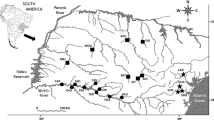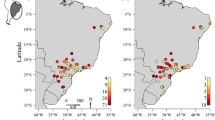Abstract
Most studies analyzing patterns in biotic homogenization of fish communities have used large-scale approaches, while the community-level effects of species introductions and local extinctions within river basins have been sparsely analyzed. In this article, we examine patterns in freshwater fish α- and β-diversity in relation to the presence of reservoirs in a Mediterranean river (Guadiana river; Iberian Peninsula). We used fish samples from 182 river localities and 59 reservoir ones to address two main questions: (i) do reservoirs favor the establishment of invasive fish species?; and (ii) do reservoirs bear taxonomically homogenized fish communities? Although total species richness was not different between rivers and reservoirs, the latter had more invasive species and less native ones. Fish species found in reservoirs tended to be larger ones, but invasive species of any size showed higher preferences for reservoirs. Native species that were rare or absent in reservoirs were those that showed higher sensitivity to invasive species in rivers. Reservoir fish communities were taxonomically homogenized in relation to river ones, both when considering all fish species and using only natives or only invasive ones. Our results suggest that invasive species occupying reservoirs constitute an ecological filter excluding most native species from such systems. Invasive species in the study area are often widely introduced elsewhere, while native species found in reservoirs are congeneric and ecologically similar to those found in other Iberian studies. Thus, we conclude that reservoirs promote taxonomic homogenization at multiple spatial scales, while could also be promoting the functional homogenization of Iberian fish communities.





Similar content being viewed by others
References
Berga-Casafont L (2003) Rivers and reservoirs in 20th century Spain. Rev Obra Públicas 3438:37–40 (in Spanish with English abstract)
Blanco-Garrido F, Clavero M, Prenda J (2009) Jarabugo (Anaecypris hispanica) and freshwater blenny (Salaria fluviatilis): habitat preferences and relationship with exotic fish species in the middle Guadiana basin. Limnetica 28:39–148
Carol J, Benejam L, Alcaraz C et al (2006) The effects of limnological features on fish assemblages in fourteen Spanish reservoirs. Ecol Freshw Fish 15:66–77
Cassey P, Lockwood JL, Blackburn TM, Olden JD (2007) Spatial scale and evolutionary history determine the degree of taxonomic homogenization across island bird assemblages. Divers Distrib 13:458–466
Clavero M, García-Berthou E (2006) Homogenization dynamics and introduction routes of invasive freshwater fish in the Iberian Peninsula. Ecol Appl 16:2313–2324
Clavero M, Blanco-Garrido F, Prenda J (2004) Fish fauna in Iberian Mediterranean basins: biodiversity, introduced species and damming impacts. Aquat Conserv 14:575–585
Clavero M, Blanco-Garrido F, Prenda J (2006) Monitoring small fish populations in streams: a comparison of four passive methods. Fish Res 78:243–251
Darwall W, Smith K, Allen D et al (2008) Freshwater biodiversity—a hidden resource under threat. In: Vié JC, Hilton-Taylor C, Stuart SN (eds) Wildlife in a changing world—an analysis of the 2008 IUCN red list of threatened species. IUCN, Gland
Didham RK, Tylianakis JM, Hutchinson MA et al (2005) Are invasive species the drivers of ecological change? Trends Ecol Evol 20:470–474
Didham RK, Tylianakis JM, Gemmell NJ et al (2007) Interactive effects of habitat modification and species invasion on native species decline. Trends Ecol Evol 22:489–496
Elvira B, Almodóvar A (2001) Freshwater fish introductions in Spain: facts and figures at the beginning of the 21st century. J Fish Biol 59:323–331
Elvira B, Almodóvar A, Nicola GG (1998) Fish communities of the middle-upper Tagus river (central Spain): a story of river regulation and exotic introductions. Pol Arch Hydrobiol 45:165–171
Encina L, Rodríguez-Ruiz A, Granado-Lorencio C (2004) Trophic habits of the fish assemblage in an artificial freshwater ecosystem: the Joaquín Costa reservoir, Spain. Folia Zool 53:437–449
García-Berthou E, Moreno-Amich R (2000) Introduction of exotic fish into a Mediterranean lake over a 90-year period. Arch Hydrobiol 149:271–284
Gasith A, Resh VH (1999) Streams in Mediterranean climate regions: abiotic influences and biotic responses to predictable seasonal events. Annu Rev Ecol Syst 30:51–81
Gido KB, Schaefer JF, Falke JA (2009) Convergence of fish communities from the littoral zone of reservoirs. Freshw Biol 54:1163–1177
Godinho FN, Ferreira MT, Portugal MC (1998) Fish assemblage composition in relation to environmental gradients in Portuguese reservoirs. Aquat Living Resour 11:325–334
Hermoso V, Blanco-Garrido F, Prenda J (2008) Spatial distribution of exotic fish species in the Guadiana river basin, with two new records. Limnetica 27:189–194
Hermoso V, Clavero M, Blanco-Garrido F, Prenda J (2009) Assessing freshwater fish sensitivity to different sources of perturbation in a Mediterranean basin. Ecol Freshw Fish 18:269–281
Hermoso V, Clavero M, Blanco-Garrido F, Prenda J (in press) Invasive species and habitat degradation in Iberian streams: an explicit analysis of their role and interactive effects on freshwater fish biodiversity loss. Ecol Appl. doi:10.1890/09-2011.1
Johnson PTJ, Olden JD, Vander Zanden MJ (2008) Dam Invaders: impoundments facilitate biological invasions into freshwaters. Front Ecol Environ 6:357–363
Kolar CS, Lodge DM (2000) Freshwater nonindigenous species: interactions with other global changes. In: Mooney HA, Hobbs RJ (eds) Invasive species in a changing world. Island Press, Washington
Kottelat M, Freyhof J (2007) Handbook of European freshwater fishes. Publications Kottelat, Cornol
La Sorte FA, McKinney ML (2007) Compositional changes over space and time along an occurrence-abundance continuum: anthropogenic homogenization of the North American avifauna. J Biogeogr 34:2159–2167
Lambdon PW, Lloret F, Hulme PE (2008) Do non-native species invasions lead to biotic homogenization at small-scales? Similarity and functional diversity of habitats compared for the alien and native components of Mediterranean floras. Divers Distrib 14:774–785
Leprieur F, Beauchard O, Hugueny B et al (2008) Null model of biotic homogenization: a test with the European freshwater fish fauna. Divers Distrib 14:291–300
Lockwood JL (2006) Life in a double-hotspot: the transformation of Hawaiian passerine bird diversity following invasion and extinction. Biol Invasions 8:449–457
Lorenzoni M, Ghetti L, Mearelli M (2006) Native and exotic fish species in the Tiber river watershed (Umbria – Italy) and their relationship to the longitudinal gradient. Bull Fr Peche Piscic 382:19–44
Magalhães MF, Batalha DC, Collares-Pereira MJ (2002) Gradients in stream fish assemblages across a Mediterranean landscape: contributions of environmental factors and spatial structure. Freshw Biol 47:1015–1031
Marchetti MP, Moyle PB (2001) Effects of flow regime and habitat structure on fish assemblages in a regulated California stream. Ecol Appl 11:530–539
Marchetti MP, Light T, Feliciano J et al (2001) Homogenization of California’s fish fauna through abiotic change. In: Lockwood JL, McKinney ML (eds) Biotic homogenization. Kluwer Academic/Plenum Publishers, New York
Marchetti MP, Moyle PB, Levine R (2004) Alien fishes in California watersheds: characteristics of successful and failed invaders. Ecol Appl 14:587–596
Marta P, Bochechas J, Collares-Pereira MJ (2001) Importance of recreational fisheries in the Guadiana river basin in Portugal. Fish Manag Ecol 8:345–354
McKinney ML (2004) Measuring floristic homogenization by non-native plants in North America. Glob Ecol Biogeogr 13:47–53
McKinney ML, Lockwood JL (1999) Biotic homogenization: a few winners replacing many losers in the next mass extinction. Trends Ecol Evol 14:450–453
Moyle PB (2002) Inland fishes of California. Revised and expanded. University of California Press, Berkeley
Moyle PB, Light T (1996) Biological invasions of fresh water: Empirical rules and assembly theory. Biol Conserv 78:149–161
Moyle PB, Mount JF (2007) Homogenous rivers, homogenous faunas. Proc Natl Acad Sci USA 104:5711–5712
Nilsson C, Reidy CA, Dynesius M, Revenga C (2005) Fragmentation and flow regulation of the world’s large river systems. Science 308:405–408
Olden JD, Poff NL (2003) Toward a mechanistic understanding and prediction of biotic homogenization. Am Nat 162:442–460
Olden JD, Poff NL (2004) Ecological processes driving biotic homogenization: testing a mechanistic model using fish faunas. Ecology 85:1867–1875
Olden JD, Rooney TP (2006) On defining and quantifying biotic homogenization. Glob Ecol Biogeogr 15:113–120
Olden JD, Kennard MJ, Pusey BJ (2008) Species invasions and the changing biogeography of Australian freshwater fishes. Glob Ecol Biogeogr 17:25–37
Poff LJ, Allan JD, Bain MB et al (1997) The natural flow regime: a paradigm for river conservation and restoration. BioScience 47:769–784
Poff NL, Olden JD, Merritt DM, Pepin DM (2007) Homogenization of regional river dynamics by dams and global biodiversity implications. Proc Natl Acad Sci USA 104:5732–5737
Rahel FJ (2000) Homogenization of fish faunas across the United States. Science 288:854–856
Ribeiro F, Beldade R, Dix M, Bochechas J (2007) Carta Piscícola Nacional, versão 01/2007. www.fluviatilis.com. Direcção Geral dos Recursos Florestais – Fluviatilis, Lda, Lisboa, Portugal
Ribeiro F, Elvira B, Collares-Pereira MJ, Moyle PB (2008) Life-history traits of non-native fishes in Iberian watersheds across several invasion stages: a first approach. Biol Invasions 10:89–102
Rincón PA, Velasco JC, González N, Pollo C (1990) Fish assemblages in small streams in western Spain: the influence of an introducer predator. Arch Hydrobiol 118:81–91
Ruiz AR (1998) Fish species composition before and after construction of a reservoir on the Guadalete river (SW Spain). Arch Hydrobiol 142:353–369
Sales-Luís T, Pedroso NM, Santos-Reis M (2007) Prey availability and diet of the Eurasian otter (Lutra lutra) on a large reservoir and associated tributaries. Can J Zool 85:1125–1135
Santos LN, Araújo FG, Brotto DS (2008) Artificial structures as tools for fish habitat rehabilitation in a neotropical reservoir. Aquat Conserv 18:896–908
Sax DF, Gaines SD (2003) Species diversity: from global decreases to local increases. Trends Ecol Evol 18:561–566
Smith KG, Darwall WRT (compilers) (2006) The status and distribution of freshwater fish endemic to the Mediterranean Basin. IUCN, Gland
Spear D, Chown SL (2008) Taxonomic homogenization in ungulates: patterns and mechanisms at local and global scales. J Biogeogr 35:1962–1975
Taylor EB (2004) An analysis of homogenization and differentiation of Canadian freshwater fish fauna with an emphasis on British Columbia. Can J Fish Aquat Sci 61:68–79
Urrea G, Sabater S (2009) Epilitic diatom assemblages and their relationship to environmental characteristics in an agricultural watershed (Guadiana river, SW Spain). Ecol Indic 9:693–703
Acknowledgments
We thank Francisco Blanco-Garrido, Arturo Menor, and the people from URS (United Research Services España) for their participation in the field study. The surveys were financed by the Confederación Hidrográfica del Guadiana through the project “Diseño y Explotación de la Red de Control Biológico de la Cuenca del Río Guadiana” and the Ministry of Science and Technology (REN2002-03513, CGL2005-02699). V. H. held a pre-doctoral fellowship funded by the Spanish Ministry of Education (MEC; AP-2004-1414), and M.C. held a Juan de la Cierva contract also funded by MEC.
Author information
Authors and Affiliations
Corresponding author
Rights and permissions
About this article
Cite this article
Clavero, M., Hermoso, V. Reservoirs promote the taxonomic homogenization of fish communities within river basins. Biodivers Conserv 20, 41–57 (2011). https://doi.org/10.1007/s10531-010-9945-3
Received:
Accepted:
Published:
Issue Date:
DOI: https://doi.org/10.1007/s10531-010-9945-3




